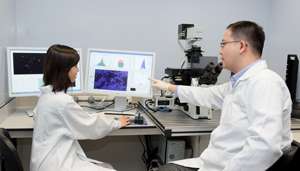Nourishing health in early life

As a newborn takes its first breath, microbes that line the mother's birth canal are already making their way into the infant's gut. And with the baby's first taste of breast milk, many more will settle in. This process of accommodating a friendly assortment of bacteria in the digestive tract—collectively referred to as the gut microbiota—is essential for healthy development and helps the infant to digest foods, synthesize vitamins and enzymes and fight pathogenic invasion.
Understanding the factors that affect the development of microbial populations in babies is the aim of a new partnership between the A*STAR Genome Institute of Singapore (GIS) and Nutricia Research, part of the international food company Danone. The investigation will involve a clinical and genomic study of the gut microbiome, which is the sum of the genomes of all the microbes that reside in the gut. "This partnership is combining the genomic expertise of the GIS, who have developed high-throughput approaches to monitoring the microbiome, with the early life nutrition and clinical expertise of Nutricia Research to investigate the health benefits of bacterial supplements," says Martin Hibberd, associate director at the GIS.
The researchers hope their findings could lead to improved infant nutrition for better health in early, and even adult, life.
Complex and resilient
A harmonious relationship with the bacteria that share our digestive tracts is increasingly being recognized as essential for good health.
"Early-life perturbations of the developing gut microbiota can have an impact on the immune, metabolic and neurological systems, and potentially lead to long-term, adverse health outcomes," says Kaouther Ben Amor, senior team leader for gut microbiology and physiology at Nutricia Research. Studies have shown that a rift in the relationship between microbes and the body can contribute to diseases in humans such as allergy, asthma, obesity, diabetes, inflammatory bowel syndrome and even autism. But while previous focus lay on identifying the patterns of microbial colonization associated with disease states, the new endeavor should help to define what a healthy bacterial population looks like—filling a gap in our current knowledge.
"A healthy microbiome has not yet been characterized in full," explains Hibberd. "We do know, though, that it is complex and in the study we will be seeking to associate this with healthy outcomes." Researchers have determined that a healthy bacterial community is not only diverse but also ecologically stable, which means that it can maintain its community structure in the face of stress or rebound to the default state following a disruption, adds Ben Amor.
Milk for health
Understanding the dynamics of the gut's microbial ecosystem and the factors that drive its development can be used to help optimize health in later life. Of particular importance is nutrition, in which the infant's mother plays a lead role. "Human milk is normally the first dietary exposure in infancy, and it is considered the best nutrition for growth and healthy development of the newborn," says Ben Amor.
Human milk contains two groups of compounds that are considered beneficial for health—prebiotics and 'good' bacteria that are also found in probiotic supplements.
Prebiotics are compounds that stimulate the growth of specific good bacteria in the large intestine. These include the nondigestible carbohydrates known as oligosaccharides found in human milk. Probiotics are live bacteria, such as species of the lactic-acid-producing Lactobacillus and Bifidobacterium, which help maintain microbial balance in the gut.
Researchers believe that a better understanding of the contribution of prebiotics, probiotics and a combination of the two—synbiotics—in fostering normal bacterial populations could be used to improve the design of nutritional products that supplement or complement human milk.
Other factors also have an effect on the development of an infant gut microbiome, says Hibberd. Antibiotics, for example, may change the pattern of bacterial colonization. Without exposure to the bacterial populations in the mother's birth canal, the gut microbiota of cesarean babies more closely resembles the microorganisms found on the surface of the mother's skin. Given the increasing rates of cesarean deliveries worldwide, including in Asia, more research is needed to investigate the implications for health of the surgical delivery of babies.
Feeding bacteria
The GIS–Nutricia Research partnership hopes to bring new insights to these nutritional aspects of infant health. Taking inspiration from human milk, it will look specifically at how the administration of prebiotics, probiotics and synbiotics modulate the gut microbiota in early life.
As part of the collaboration, Nutricia Research will focus on conducting two clinical studies in Asia. The studies will investigate how supplements of nutrition can support establishment of the microbiome in early life and help prevent disease later in life.
Samples taken from the gastrointestinal tracts of study participants will be analyzed using the GIS's state-of-the-art genomic technologies and advanced analysis techniques. This will allow researchers to characterize the genomic content of the entire microbial community and develop a molecular understanding of the benefits associated with nutritional supplements.
"Microbiome research is an exciting frontier and it leverages on the GIS's core capability to analyze and study the complex community of microbes," says Huck Hui Ng, executive director of the GIS. Only recently, the GIS developed a method for identifying the complement of species that constitute complex microbial communities, which is more comprehensive and cost-effective than existing techniques and can be applied to large-scale studies.
A nutritional boost
Hibberd expects that the nutritional supplements will contribute to an increase in microbial diversity in the infant gut, thus generating health benefits for the study population. With time, these findings could translate into new nutritional products, specifically designed to address the needs of target groups such as babies born by cesarean delivery. "Very little science has been published on the health benefits of different milk formulae in promoting healthy gut microbiomes up to now," says Hibberd. "We hope that our study will benefit the field by generating this new knowledge."

















